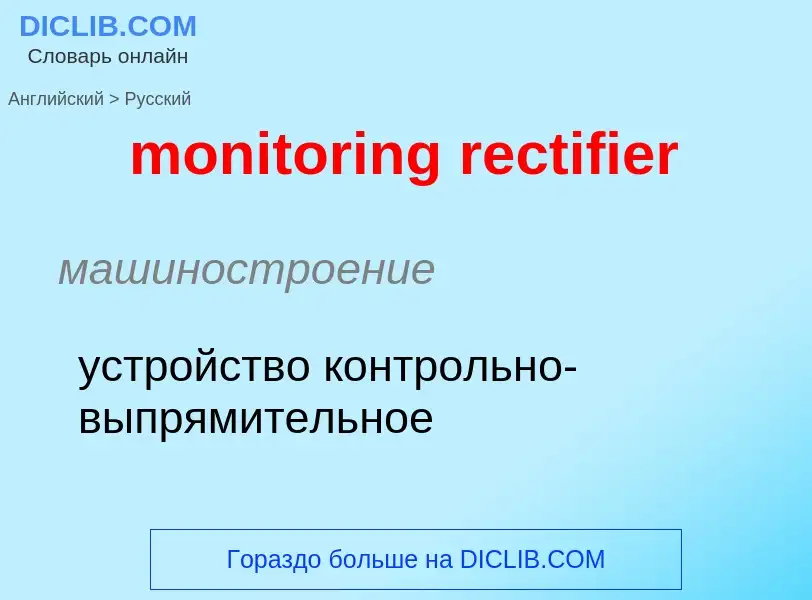Перевод и анализ слов искусственным интеллектом ChatGPT
На этой странице Вы можете получить подробный анализ слова или словосочетания, произведенный с помощью лучшей на сегодняшний день технологии искусственного интеллекта:
- как употребляется слово
- частота употребления
- используется оно чаще в устной или письменной речи
- варианты перевода слова
- примеры употребления (несколько фраз с переводом)
- этимология
monitoring rectifier - перевод на русский
машиностроение
устройство контрольно-выпрямительное
['mɔnit(ə)riŋ]
общая лексика
регистрация функций организма с сигнализацией об отклонениях от нормы
мониторинг
перманентный контроль
слежение (напр. за состоянием среды)
дозиметрический контроль
дозировка
слежение, контроль, мониторинг
контролирование
контролирующий
контроль
контроль подслушиванием
контрольно-выпрямительный
контрольный
коррекция гироскопа
подслушивание
проверка
управление
управляющий
медицина
дозиметрия
мониторное наблюдение
наблюдение
мониторирование
регулирование
строительное дело
контроль, мониторинг (непрерывное наблюдение переменной)
дистанционный диспетчерский контроль
нефтегазовая промышленность
текущий контроль
Смотрите также
существительное
общая лексика
контроль
подслушивание
радиоперехват
физика
дозировка
дозиметрический контроль
Определение
Википедия
A mercury-arc valve or mercury-vapor rectifier or (UK) mercury-arc rectifier is a type of electrical rectifier used for converting high-voltage or high-current alternating current (AC) into direct current (DC). It is a type of cold cathode gas-filled tube, but is unusual in that the cathode, instead of being solid, is made from a pool of liquid mercury and is therefore self-restoring. As a result mercury-arc valves, when used as intended, are far more robust and durable and can carry much higher currents than most other types of gas discharge tube. Some examples have been in continuous service, rectifying 50 ampere currents for decades.
Invented in 1902 by Peter Cooper Hewitt, mercury-arc rectifiers were used to provide power for industrial motors, electric railways, streetcars, and electric locomotives, as well as for radio transmitters and for high-voltage direct current (HVDC) power transmission. They were the primary method of high power rectification before the advent of semiconductor rectifiers, such as diodes, thyristors and gate turn-off thyristors (GTOs) in the 1970s. These solid state rectifiers have almost completely replaced mercury-arc rectifiers thanks to their higher reliability, lower cost and maintenance and lower environmental risk.

![An experimental mercury arc amplifier for use on long-distance telephone circuits. It was never commercially used after the development of the [[audion]] tube. An experimental mercury arc amplifier for use on long-distance telephone circuits. It was never commercially used after the development of the [[audion]] tube.](https://commons.wikimedia.org/wiki/Special:FilePath/Bell telephone magazine (1922) (14756303342).jpg?width=200)

![A 150-[[kilovolt]], 1800 amp mercury-arc valve at [[Manitoba Hydro]]'s Radisson converter station, August 2003 A 150-[[kilovolt]], 1800 amp mercury-arc valve at [[Manitoba Hydro]]'s Radisson converter station, August 2003](https://commons.wikimedia.org/wiki/Special:FilePath/Mercury Arc Valve, Radisson Converter Station, Gillam MB.jpg?width=200)
